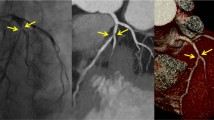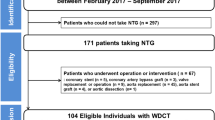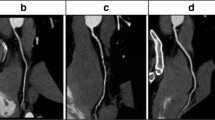Abstract
A new generation of high definition computed tomography (HDCT) 64-slice devices complemented by a new iterative image reconstruction algorithm—adaptive statistical iterative reconstruction, offer substantially higher resolution compared to standard definition CT (SDCT) scanners. As high resolution confers higher noise we have compared image quality and radiation dose of coronary computed tomography angiography (CCTA) from HDCT versus SDCT. Consecutive patients (n = 93) underwent HDCT, and were compared to 93 patients who had previously undergone CCTA with SDCT matched for heart rate (HR), HR variability and body mass index (BMI). Tube voltage and current were adapted to the patient’s BMI, using identical protocols in both groups. The image quality of all CCTA scans was evaluated by two independent readers in all coronary segments using a 4-point scale (1, excellent image quality; 2, blurring of the vessel wall; 3, image with artefacts but evaluative; 4, non-evaluative). Effective radiation dose was calculated from DLP multiplied by a conversion factor (0.014 mSv/mGy × cm). The mean image quality score from HDCT versus SDCT was comparable (2.02 ± 0.68 vs. 2.00 ± 0.76). Mean effective radiation dose did not significantly differ between HDCT (1.7 ± 0.6 mSv, range 1.0–3.7 mSv) and SDCT (1.9 ± 0.8 mSv, range 0.8–5.5 mSv; P = n.s.). HDCT scanners allow low-dose 64-slice CCTA scanning with higher resolution than SDCT but maintained image quality and equally low radiation dose. Whether this will translate into higher accuracy of HDCT for CAD detection remains to be evaluated.



Similar content being viewed by others
Abbreviations
- ASIR:
-
Adaptive statistical iterative reconstruction
- CT:
-
Computed tomography
- CCTA:
-
Coronary computed tomography angiography
- CAD:
-
Coronary artery disease
- HDCT:
-
High definition computed tomography
- SDCT:
-
Standard definition computed tomography
References
Leber AW et al (2005) Quantification of obstructive and nonobstructive coronary lesions by 64-slice computed tomography: a comparative study with quantitative coronary angiography and intravascular ultrasound. J Am Coll Cardiol 46(1):147–154
Raff GL et al (2005) Diagnostic accuracy of noninvasive coronary angiography using 64-slice spiral computed tomography. J Am Coll Cardiol 46(3):552–557
Mollet NR et al (2005) High-resolution spiral computed tomography coronary angiography in patients referred for diagnostic conventional coronary angiography. Circulation 112(15):2318–2323
Scheffel H et al (2006) Accuracy of dual-source CT coronary angiography: first experience in a high pre-test probability population without heart rate control. Eur Radiol 16(12):2739–2747
Husmann L et al (2008) Feasibility of low-dose coronary CT angiography: first experience with prospective ECG-gating. Eur Heart J 29(2):191–197
Budoff MJ et al (2006) Assessment of coronary artery disease by cardiac computed tomography: a scientific statement from the American Heart Association Committee on Cardiovascular Imaging and Intervention, Council on Cardiovascular Radiology and Intervention, and Committee on Cardiac Imaging. Council on Clinical Cardiology. Circulation 114(16):1761–1791
Schroeder S et al (2008) Cardiac computed tomography: indications, applications, limitations, and training requirements: report of a Writing Group deployed by the Working Group Nuclear Cardiology and Cardiac CT of the European Society of Cardiology and the European Council of Nuclear Cardiology. Eur Heart J 29(4):531–556
Fox K et al (2006) Guidelines on the management of stable angina pectoris: executive summary: the Task Force on the Management of Stable Angina Pectoris of the European Society of Cardiology. Eur Heart J 27(11):1341–1381
Pundziute G et al (2007) Prognostic value of multislice computed tomography coronary angiography in patients with known or suspected coronary artery disease. J Am Coll Cardiol 49(1):62–70
Min JK et al (2007) Prognostic value of multidetector coronary computed tomographic angiography for prediction of all-cause mortality. J Am Coll Cardiol 50(12):1161–1170
Gilard M et al (2007) Midterm prognosis of patients with suspected coronary artery disease and normal multislice computed tomographic findings: a prospective management outcome study. Arch Intern Med 167(15):1686–1689
Ostrom MP et al (2008) Mortality incidence and the severity of coronary atherosclerosis assessed by computed tomography angiography. J Am Coll Cardiol 52(16):1335–1343
Gaemperli O et al (2008) Coronary 64-slice CT angiography predicts outcome in patients with known or suspected coronary artery disease. Eur Radiol 18(6):1162–1173
Chow BJ et al (2010) Prognostic value of 64-slice cardiac computed tomography severity of coronary artery disease, coronary atherosclerosis, and left ventricular ejection fraction. J Am Coll Cardiol 55(10):1017–1028
Hadamitzky M et al (2009) Prognostic value of coronary computed tomographic angiography for prediction of cardiac events in patients with suspected coronary artery disease. JACC Cardiovasc Imaging 2(4):404–411
Chow BJ et al (2011) Incremental prognostic value of cardiac computed tomography in coronary artery disease using CONFIRM: COroNary computed tomography angiography evaluation for clinical outcomes: an InteRnational Multicenter registry. Circ Cardiovasc Imaging 4(5):463–472
Husmann L et al (2009) Low-dose coronary CT angiography with prospective ECG triggering: validation of a contrast material protocol adapted to body mass index. AJR Am J Roentgenol 193(3):802–806
Pazhenkottil AP et al (2010) Validation of a new contrast material protocol adapted to body surface area for optimized low-dose CT coronary angiography with prospective ECG-triggering. Int J Cardiovasc Imaging 26(5):591–597
Einstein AJ et al (2007) Radiation dose to patients from cardiac diagnostic imaging. Circulation 116(11):1290–1305
Austen WG et al (1975) A reporting system on patients evaluated for coronary artery disease. Report of the ad hoc committee for grading of coronary artery disease, council on cardiovascular surgery, American Heart Association. Circulation 51(4 Suppl):5–40
Heydari B et al (2011) Diagnostic performance of high-definition coronary computed tomography angiography performed with multiple radiation dose reduction strategies. Can J Cardiol 27(5):606–612
Herzog BA et al (2009) Low-dose CT coronary angiography using prospective ECG-triggering: impact of mean heart rate and heart rate variability on image quality. Acad Radiol 16(1):15–21
Husmann L et al (2007) Coronary artery motion and cardiac phases: dependency on heart rate—implications for CT image reconstruction. Radiology 245(2):567–576
Buechel RR et al (2011) Low-dose computed tomography coronary angiography with prospective electrocardiogram triggering: feasibility in a large population. J Am Coll Cardiol 57(3):332–336
Mulkens TH et al (2005) Use of an automatic exposure control mechanism for dose optimization in multi-detector row CT examinations: clinical evaluation. Radiology 237(1):213–223
Vehmas T et al (2005) Scoring CT/HRCT findings among asbestos-exposed workers: effects of patient’s age, body mass index and common laboratory test results. Eur Radiol 15(2):213–219
Tatsugami F et al (2009) Evaluation of a body mass index-adapted protocol for low-dose 64-MDCT coronary angiography with prospective ECG triggering. AJR Am J Roentgenol 192(3):635–638
Min JK et al (2009) High-definition multidetector computed tomography for evaluation of coronary artery stents: comparison to standard-definition 64-detector row computed tomography. J Cardiovasc Comput Tomogr 3(4):246–251
Acknowledgments
The study was supported by grants from the Swiss National Science Foundation (SNSF) to PAK and to MF. Furthermore, we thank Ennio Müller for the excellent technical support.
Conflict of interest
None.
Author information
Authors and Affiliations
Corresponding author
Additional information
Egle Kazakauskaite, Lars Husmann, Oliver Gaemperli and Philipp A. Kaufmann contributed equally to this work.
Rights and permissions
About this article
Cite this article
Kazakauskaite, E., Husmann, L., Stehli, J. et al. Image quality in low-dose coronary computed tomography angiography with a new high-definition CT scanner. Int J Cardiovasc Imaging 29, 471–477 (2013). https://doi.org/10.1007/s10554-012-0100-y
Received:
Accepted:
Published:
Issue Date:
DOI: https://doi.org/10.1007/s10554-012-0100-y




